A whopping 70% of all search traffic comes from long-tail keywords. So, if you’re not including long-tail terms in your SEO strategy, you’re missing out on a lot of potential organic opportunities.
What are long-tail keywords?
Long-tail keywords are longer and more specific search terms people use when looking for very specific information. For example, instead of typing in “multivitamin”, people may type in more defined terms like “multivitamin for weight gain”, “multivitamin with iron for kids”, or “multivitamin for hair”.
Core keywords like “multivitamin” are also called “head keywords” or “seed keywords” with greater popularity and thus higher search volume. The typical first instinct of someone who’s just starting out in SEO is to target these big, seed keywords with higher search demand.
For example, if one is operating in the health supplement niche, new webmasters may be inclined to target keywords like “Vitamin C” with 1.2 million monthly search volume, foregoing other less popular yet high-intent keywords like “vitamin c for teens” or “vitamin c for acid reflux”.
Why use long-tail keywords?
Going more granular with your keyword strategy has a lot of benefits and can help you achieve your SEO goals easier and faster. The following are all the big reasons to double down on long-tail queries:
1. Better Conversions
The more specific the search term, the closer the user is to the bottom of the funnel. In fact, someone who types in super broad terms like “coffee” is probably just out there trying to grab a picture of coffee or looking for general information.
On the other hand, if someone goes in and types “arabic coffee with cardamom and saffron”, you bet that someone is all ready to transact and make a purchase.
You still need to use keyword research tools to validate any long-tail query, but you shouldn’t target keywords based solely on search popularity because, at the end of the day, conversion and engagement are the biggest goals.
2. Lower Competition
Going back to the health supplement example, let’s assume you really want to rank for the gigantic keyword “vitamin c” with 1.2 million monthly searches. That’s a lot of eyeballs and attention if you do manage to make it to page 1. However, you’re also competing against colossal websites like Mayo Clinic and Wikipedia. Even if you spend hours trying to optimize a page you want to go up against the big players, there’s still no guarantee it would measure up.
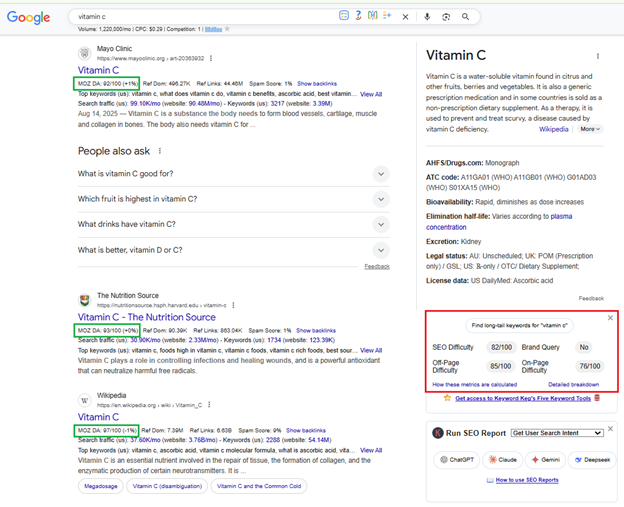
The more strategic route, especially if you’re a newer website, is to do proper keyword research and pool all long-tail keywords relevant to your offerings. Categorize long-tail keywords according to search intent and go take your shot at optimizing product/service pages and blog pages to engage all leads across every stage of the buying journey.
3. High Collective Search Volumes When Grouped
People express the same search intent differently. For example, when someone is looking for “best coffee for acid reflux”, you’re not limited to just optimizing for this keyword. You can expand your keyword ideas and target all other versions with the same search intent. The query best coffee for acid reflux has a monthly search volume of 1600, but if you add in all other similar keywords like the list below, that would amount to over 35,000 and even more if you further tap into other relevant queries.
- best coffee for acid reflux (1600)
- coffee for gerd (8,100)
- low acid coffee (22000)
- coffee for heartburn (1300)
- non-acidic coffee (2400)
Using Keywords Everywhere, you don’t only get grouped and categorized search terms according to widgets; you can also make use of its browser add-on Keyword Planner, which automatically chunks similar keywords together.

Also Read: How to Use Keyword Planner
4. Broader Coverage
Besides the fact that you can expand a long-tail keyword’s coverage by targeting multiple variations of it, there are also endless long-tail keyword opportunities in general. In fact, according to an Ahrefs report, around 94% of keywords have a search volume of 10 or lower. This means the majority of search demand lives in these less obvious, highly targeted queries that most competitors ignore.
5. Even More Popular with Voice Search
Over 71% of internet users prefer voice search over typing, and people tend to use more words when talking than when entering text. That naturally pushes queries into long-tail territory, making it easier to capture voice-driven traffic when your content matches conversational phrasing.
6. Greater Chances of Appearing in AI Responses
AI-generated responses are now playing a key role in consumer behavior, and the more you optimize your content for GEO, the more chances for engagement and discoverability.
Long-tail keywords, being natural and specific, tend to align with users’ language better, thus influencing how AI interprets and retrieves information. Also, Google’s AI Mode and other large language models also tend to use query fan-out. It’s when AI engines expand a single query into multiple sub-queries to generate richer, more comprehensive results. Using long-tail keywords also naturally increases the chances of hitting sub-queries that could influence AI responses.
How to Find Long-tail Keywords
There are many ways to discover long-tail keywords. Even without being subscribed to a keyword research tool, you can already explore specific search terms you can target.
1. Google’s Autosuggest and Related Searches
Google’s autocomplete feature and the Related Searches at the bottom of SERPs all offer real-time and free insights into what users are actively searching for. Lots of these are long-tail queries you can target to attract qualified traffic and build stronger topical authority.
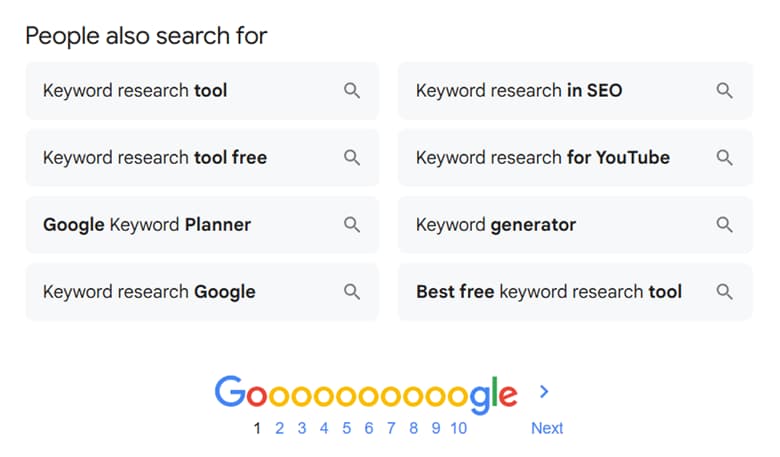
If you want to take the guesswork out of keyword research, download our Keywords Everywhere extension to view actual search volume and other keyword-level data of the autosuggested keywords as shown below:
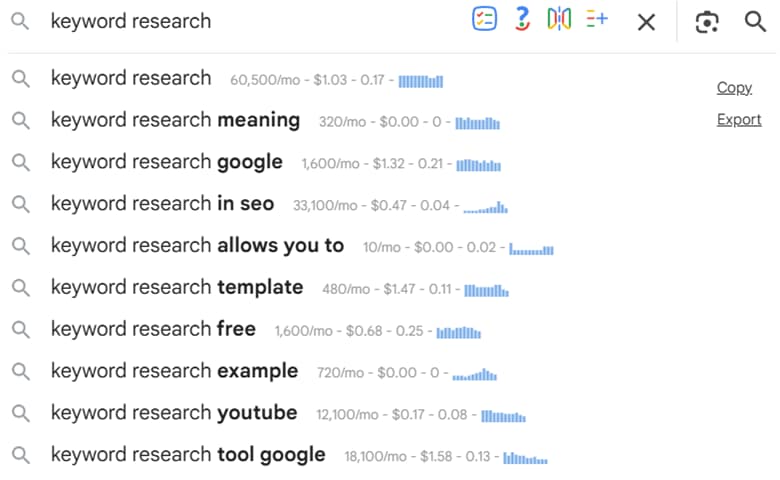
Also Read: How to Do Keyword Research Using Keywords Everywhere
2. Google Search Console Performance Report
On Google Search Console, you can check every article’s performance and see which keywords are driving clicks and impressions. If you look into these performance reports, you’d find that some of your articles may be ranking for a specific query you’re not necessarily targeting.
For example, we published an article about Local SEO: The Ultimate Guide to Ranking in 2025, and it’s appearing for the search term “how to do keyword research for multiple locations”. Even if the article does have a small section about ensuring localized content, the whole article is not predominantly about how to do keyword research for multiple locations. It’s a different search intent that can be properly targeted in a separate, dedicated page.
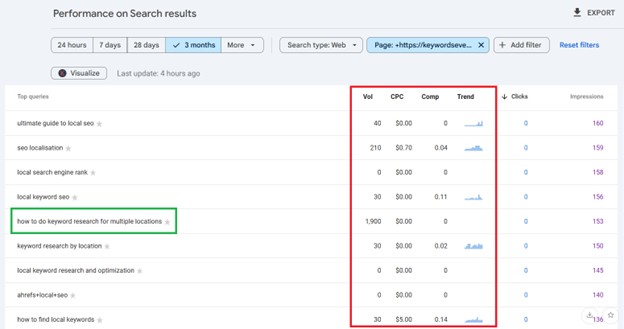
Another big reason to get the Keywords Everywhere extension is that it also layers over the search volume and other keyword-level data straight from Google Search Console. This way, you’re more readily equipped to choose in-demand long-tail keywords that are ripe for the taking.
3. Google Trends
Google Trends is also another free tool you can use for long-tail keyword research. It doesn’t only help identify trending topics but also allows you to compare different terms and check the potential long-term popularity of any given search term. Google Trends is one of the many platforms Keywords Everywhere also supports, so you’re able to also validate keyword ideas and check search volume without needing to switch tabs.
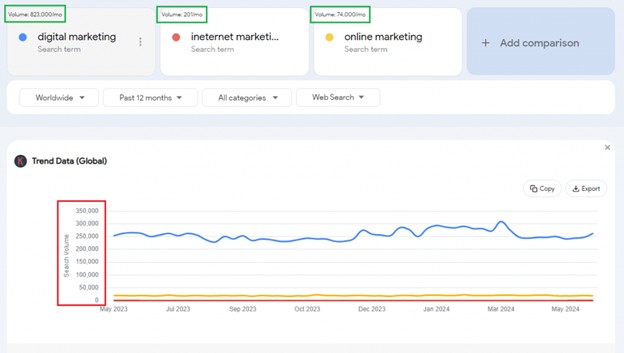
Also Read: How to Use Google Trends for SEO
4. Forums
Nothing indicates search demand better than actual pain points and content gaps forums reveal. Although some of these questions may be too specific to target, you’re also satisfying really specific queries that can drive highly targeted traffic.
Taking the time to explore discussions on forums relevant to your niche can help uncover high-value keyword ideas that can drive conversion, boost sign-ups, or simply build trust. Explore Quora, Reddit and even Facebook and LinkedIn groups to spot the conversations your audience cares about most. To save time, you can also type “site:forum + topic” into Google’s search bar.
5. ChatGPT
ChatGPT is a great tool for brainstorming ideas and can even help you think more ‘outside the box’. Although search volumes still need to be validated using keyword research tools, ChatGPT can definitely help speed up the process and give you a broader range of potential terms to consider. You can further expand long-tail keyword opportunities by using our Fan-Out Queries feature on ChatGPT.
6. Use a Handy-Dandy Keyword Research Tool
Keyword research tools not only take the guesswork out of process, but they can also do a lot more including competitive research, SERP analysis, and other crucial functions like verifying trend data, search volume, keyword difficulty, and so on.
Even if you’re confident that you know your audience like the back of your hand, there’s no way to beat historical data and insights based on actual user behavior, mindset, and intent.
Choosing the Best Long Tail Keyword Research Tool
All keyword research tools will naturally help you find long-tail keywords. Some are even specially designed to target hyper-relevant queries. However, the best criteria for choosing the best long-tail keyword research tool should include:
- Keyword grouping
- Accuracy
- Database
- Usability and interface
- Cost and overall value proposition
If you’re new to SEO or don’t need a full marketing dashboard, Keywords Everywhere is an easy-to-use long-tail keyword research tool that helps you ideate content and emerging topics with ease.
Keywords Everywhere pulls data directly from Google Ads Keyword Planner and/or Clickstream, with a database of around 5 billion keywords for each country.
For only $5 per month, you can access fast wins in your long-tail keyword strategy on the fly. No need to switch between tabs. You can access keyword insights directly on the platforms supported including Google, YouTube, Amazon, Etsy, Google Search Console, Google Trends, and 14+ other major platforms.
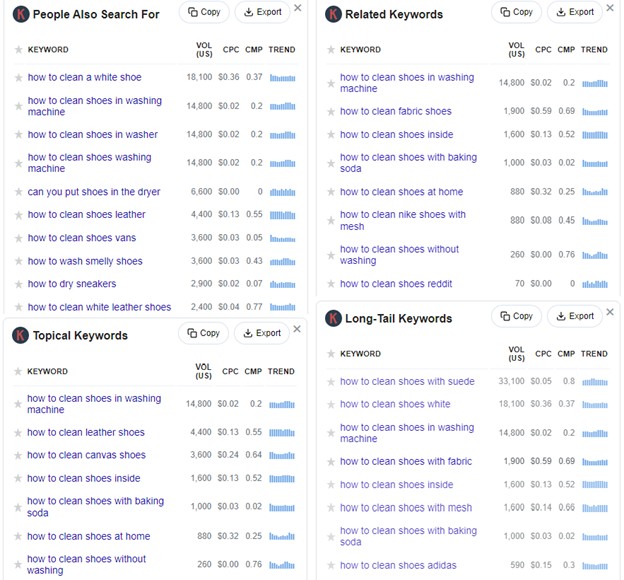
Now, remember: keyword research is just the foundation but not the full house. SEO is a big picture, and there are more layers to optimize to start ranking and gaining traction.
How to Rank for Long-Tail Keywords
It’s generally true that long-tail keywords can make it easy for newer sites to rank fast and easy due to lower competition. However, keyword presence is not enough. Google rewards value and usefulness above all else. Plus, there are hundreds of other Google ranking factors, so the process is a bit more nuanced than you think.
1. Create dedicated content for each targeted longtail query
It’s not enough to add long-tail queries to existing pages. For best results, every high-value long-tail keyword should have a specific, well-written page with all of its keyword variations.
2. Perform on-page optimization
Optimize the meta descriptions, images, URLs, schema markup, site speed, mobile responsiveness, alt text, canonical tags– essentially the full shebang.
3. Use internal links
Internal linking is technically still an on-page optimization method, but it’s worth singling out as a way to guide both users and search engines to other valuable content on your website.
4. Focus on creating the best content possible
Most importantly, strive to be the best resource for such a query. Google’s ranking system is essentially a recommendation system, and only the best content gets recommended.
How to Create a Long Tail Keyword Strategy
Besides thinking about ranking, you also need to consider the broader long-tail SEO strategy. For example, it’s not enough to generate impressions on SERPs. Another big goal is to generate more clicks, which you can achieve using another set of strategies like creating irresistible headlines that inspire actual visits.
To make your long-tail keyword strategy as comprehensive and lucrative as possible, consider the tips below.
1. Prioritize business potential
A keyword is only ever useful if it supports your bottom line, which ultimately is about leads and conversion. Perhaps there’s a highly promising long-tail keyword relevant to your industry with decent search volume and fairly easy keyword difficulty. However, not all keywords under your niche have actual business potential.
For example, a long-tail keyword like “how to build a website for free” may have high search volume but low business potential. It’s best to choose keywords that would ultimately and readily translate to conversion and revenue.
Even better, you can map keywords according to the buyer’s journey. Plot long-tail queries according to the following stages:
- Awareness: what is the easiest way to build a website
- Consideration: affordable website design services near me
- Decision: build a business website with hosting included
It’s important to consider all stages since not all users are ready to buy. The goal is to equip and capture every potential customer wherever they are in the journey.
2. Cover as many high-value long-tail keywords as possible
There’s a plethora of topics and information that every user will look for at each stage of the buying journey. The key is to think like a buyer and consider all specific details like size, materials, color, location, or even occasion and budget. Using a laptop product example, you can explore keywords like:
- best small laptop for gaming
- black and white laptop
- metal body laptop
- laptop stores in chicago
- laptop for digital nomad
- best laptops under 500
3. Mention keywords in the right places
We’ve already established that it’s no longer about keyword density and frequency. However, strategic keyword placement still holds significance as thoughtful keyword integration in the right places can still help search engines understand your content and overall topic authority.
Now, where do you place long-tail keywords? Strategic placement involves mentioning your primary long-tail keyword in the following places:
- Title tag
- Headings (H1, H2, etc.)
- Meta description
- URL slug
- First 100–200 words
- Image alt text
- Internal links
4. Front load keyword in the title and make title click-worthy
Frontloading involves using the keyword at the beginning of a title tag, headline, or sentence. People who scan SERPs typically only read the first few words, so putting the keyword first makes it far more likely to catch their attention. Plus, Google tends to truncate titles, so using important keywords at the beginning ensures that the most important message always comes across. Studies also show that the first few words in a title carry more weight in Google’s relevance calculations. Overall, it’s a simple optimization that delivers strong SEO gains.
Another best practice is to make the title click-worthy. Search engine ranking is a good goal, but clicks are just as important in SEO. A great way to boost click-through rates (CTR) is to make the title clear, compelling, and engaging. You can also use language that piques curiosity and adds more context in parentheses or brackets.
For example, if you’re targeting the long-tail keyword “keyword research for beginners”, good examples of title tags that front-load keywords, align with search intent, and remain engaging for users include:
- Keyword Research for Beginners – #1 Trick I Wish I Knew
- Keyword Research for Beginners (Tools + Proven Tactics)
- Keyword Research for Beginners – The SEO Blueprint 2025
- Keyword Research for Beginners: How I Got 100K Visits
- Keyword Research for Beginners [The Lazy Way to Rank]
- Keyword Research for Beginners [Secret Formula Revealed]
However, take note that while it’s important to evoke an emotional response, you should avoid clickbaiting for the sake of it. You should be able to 100% meet your title’s promise to actually earn people’s trust and become a memorable authority figure in the process.
If you’re not looking to cover any specific angle and just want a general and comprehensive title that still works. You can use Keywords Everywhere’s AI SEO Reports feature that automatically suggests titles that match the search intent and the ranking pages on the SERP. Using the keyword example, ‘keyword research for beginners’, our tool will help instantly suggest options like:
- Keyword Research for SEO: Beginner’s Step-by-Step Guide
- Keyword Research for Beginners: The Definitive SEO Guide
- Keyword Research for Beginners: Expert Guide for 2025
- Keyword Research for Beginners: A Complete SEO Guide
Read Full Tutorial: SERP Analysis Through AI SEO Reports: Keywords Everywhere
5. Avoid overstuffing keywords
While it’s important to mention semantically related words for SEO and GEO purposes, it’s important to do so in a natural and reader-focused manner.
Overstuffing long-tail keywords not only risks search engine penalties but also creates unreadable content, poor user experience, and even reputational damage. Your credibility matters more than anything else, and becoming a trusted resource in your industry is always the ultimate goal.
Your best bet is to just focus on creating content that’s unique, valuable, and enjoyable. Just do what you can to satisfy the search intent and ease the pain point behind it. Being genuinely helpful on the internet would compel users to remember you and go back to you for answers and solutions.
FAQs
When to use long-tail keywords?
Whether you’re publishing blog articles, product descriptions, web copy, or even tutorials and case studies, long-tail keywords can be a great opportunity to build traction and authority by solving specific problems.
Does having a focus keyword still matter?
Having a focus keyword is still important for better targeting and discoverability. You should choose the right search term that represents the core topic of the page. This not only helps with SEO but also guides your content creation process and makes your SEO strategy more intentional.
Does keyword usage have to be an exact match?
It helps to strategically use the focus keyword in key areas like titles, meta descriptions, intro, and URL, but keyword mentions don’t have to go too repetitive or verbatim. Search engines can already understand synonyms and semantics in a very sophisticated sense.
Conclusion
Long-tail keywords are definitely one of the secret tools in a seasoned marketer’s toolkit. Exploring more long-tail keywords means tapping an endless source of new audience segments while unlocking cool content ideas that connect, convert, and build trust.
Ready to put all long-tail keywords to work? Install Keywords Everywhere and let data guide your content strategy!


